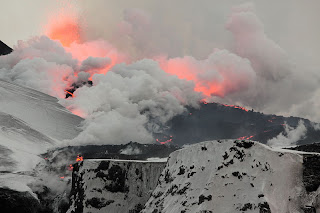 |
| The Mid-Atlantic ridge; a divergent techtonic plate spreads about 2.5 cm per year. (Red triangles show active volcanoes) http://en.wikipedia.org/wiki/File:Iceland_Mid-Atlantic_Ridge_Fig16.gif |
Continuing plate movements, along with the hot spot (a volcanic region beneath the Earth's mantle) under Southern Iceland makes the area high in volcanic activity. The most recent volcanic activity was the eruption of Eyjafjallajokull in early 2010. Eyjafjallajokull is an extrusive composite volcano and until 2010 had been dormant for around 200 years. As seen below, Eyjafjallajokull has the distinct steep sides and large size of a composite volcano.
 |
| Photo taken after the eruption of Eyjafjallajokull. Large volumes of ash and gas filled the air for weeks afterwards. http://public.pwdlabs.com/BlogFiles/2010-04/Jim_Graham_Iceland/2010_04_12_Eyjafjallajoekull_Volcano-0014.jpg |
Although a rather small eruption, Eyjafjallajokull caused hundreds of people from nearby villages at the base to be evacuated after shooting tephra and lava into the surrounding air. Caustic, sulphurous gases were the most immediate threat to the people and livestock and no injuries were reported according to medical reports. Over a period of six days, air travel across northern and western Europe slowed to a halt due to large amounts of ash suspended in the atmosphere. (http://en.wikipedia.org/wiki/2010_eruptions_of_Eyjafjallaj%C3%B6kull)
 |
| Fissures (cracks) along the side of Eyjafjallajokull. http://en.wikipedia.org/wiki/File:Fimmvorduhals_second_fissure_2010_04_02.JPG |
 |
| Ash and sulpher compounds in the stratosphere create what is known as "volcanic lavendar" against the setting sun. http://en.wikipedia.org/wiki/File:Volcanic_Lavender.jpg |
Sources:
:)
ReplyDeleteIceland looks like a great place to demonstrate volcanism- Good pick. Your pictures and explanations were very helpful in understanding the forms that were produced by the processes discussed. Though a little repetitive in the discussion of the composite volcano, I thought it was good how you guys didn't simply say it was a composite volcano, but explained why you could tell. To add to that, I found the mention of how drastically dangerous an explosion from these types of volcanoes can be even though no injuries were reported. Most of your blog takes what we learned in class and applies it directly to your location, which is what we are supposed to do, but I'm glad you also put the information about volcanic lavender.
ReplyDeleteThe one thing I found to make the blog flow less smoothly was your style of citation. Keeping in-text citations shorter and closer to MLA, APA, or Chicago style format. For example, instead of quoting the whole HTML of the source in text, have a title in a works cited section below and use that for your in-text citation.
Overall, very informative and the organization of building from plate tectonics to volcanism to a particular volcano to the effects of this volcano made sense. I found nothing in here to argue with scientifically speaking.
Oh and this comment is by Jane Nelson.
Delete